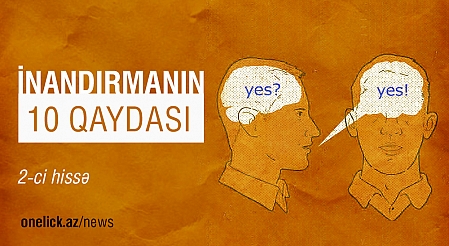- Oneclick.az
- Xəbərlər
- Business
- Ten rules of persuasion (part 2)
Ten rules of persuasion (part 2)

Sixth rule: wanting to persuade, not to start with the moment separating you and start from those moments that the interlocutor will agree with you.
Seventh rule: Be empathic
Empathy is the ability to comprehend the emotional state of another person in the form of empathy. Empathy helps to understand the interlocutor better, to present his thoughts, as they say, "Get into his skin." Not showing empathy, it is impossible to perform the first rule (Homer). Indeed, the strength of the arguments we have to evaluate from a consumer perspective, i.e. we have to put ourselves in his place. The same is applied to the rules of Socrates - you need to anticipate consumers' reaction to your words, i.e., again to show him empathy. Similarly, for the use of the image and status in the process of persuasion, it is necessary to assess the status and image of persuasive character from the interlocutor’s point of view. Empathy is required, and for the next rule.
Eighth rule: avoid of the contentiousness
Conflictogenic is called so words, actions (or inaction), which can lead to conflict. The literal translation of the word – is "giving birth to conflicts", the end of the word "genic" means "born" in a compound word. The word "giving" is the keyword here. It reveals the cause of conflictogenic danger. It does not always lead to conflict and it reduces our vigilance towards it. For example, uncivil treatment does not always lead to conflict, and therefore idea is arisen in many that "it will get away." However, it often doesn’t "meet" and leads to conflict.
Ninth rule: facial expressions, gestures and postures of persuasive should reinforce the words, to be friendly to the audience
Facial expressions – is the main indicator of the senses. Positive emotions are most easily recognized - happiness, love and wonder. It is difficult to perceive, as a rule, negative emotions - sadness, anger and disgust. The emotions associated with facial expressions are usually as follows: surprise - raised eyebrows, wide - open eyes, drooping tips of the lips, open mouth; fear - raised and flattened over the bridge of his eyebrows, wide - open eyes, the corners of the lips are omitted and some laid back, lips stretched to the side, mouth can be opened; anger - eyebrows are lowered, wrinkles on the forehead bent, eyes narrowed, lips closed, teeth clenched; aversion - eyebrows lowered, nose wrinkled, lower lip is hidden or raised and link up with the upper lip; sadness - eyebrows kept eyes dimmed, often the outer corners of the lips slightly lowered; happiness - calm eyes, outer corners of the lips are raised and usually laid back. Artists and photographers have already known that a person's face is asymmetrical, with the result that the left and right sides of our faces reflect emotions differently. Recent studies have explained it by the fact that the left and right sides of the face are controlled by different brain hemispheres. The left hemisphere controls speech and intellectual activity, the right one manages emotions, imagination and sensory activity. Communication management is overlapped: the work of the left hemisphere is reflected on the right side of the face and gives it an expression of amenable greater control. Since the work of the right hemisphere of the brain affects the left side of the face, then on this side it is more difficult to hide feelings. Positive emotions are reflected more evenly on both sides of the face, negative emotions are clearly expressed on the left side. However, the two hemispheres of the brain are functioning together, so differences are described by the nuances of expression.
Tenth rule: show that you propose will satisfy some of the needs of the listener
We have already said that, according to the classification of Maslow, human needs are divided into five types. It is appropriate to complement them with one of the most important psychological needs - the need for positive emotions.
All of these requirements are a source for finding the strongest arguments of persuasive. The opportunity offered by you on meeting some of the needs of the person is a strong argument.
Author: Nikolai Ivanovich Timchenko, a member of the International Academy of information, information processes and technologies (IAS IPT).






